|
Restoration of Coast Redwood Forests
How does one restore the superlative? Managers of coast redwood Parks and Reserves are confronted with this extraordinary question daily. Unlike most Parklands of the West that never left the public domain, the jewels of conservation that we know today as Humboldt Redwoods, Muir Woods, Redwood National Park and Headwaters Reserve were at one time privately owned. Portions of these areas were logged. Even the tallest surviving trees on earth came close to becoming simple commodities, and the tallest that had existed probably did. |
|
As a result of this circuitous history of public ownership, Park acquisitions were incremental, beginning along roadside corridors in the 1920s and encompassing entire watersheds following the severe 1964 flood. Today, Parks and Reserves include a mosaic of even-aged patches of regenerating forest that surrounds scattered groves of unlogged old growth.
Reclaiming Second Growth
The need for restoring areas that had been logged to a condition that better resembles old growth is a key objective of Parks and Reserves across the coast redwood range (Thornburgh et al. 2000). But what exactly can we hope for, even with the best possible management? What might slow or prevent restoration efforts, and how might threats be minimized? Those who struggle with these issues on the ground focus on a practical objective--to accelerate succession in an old-growth-like direction by reducing post-logging tree densities and undesired tree species. But at what point do we claim success?
Imagine if we could travel through time and see these stands 200 years post-logging. What would we expect to see? Fewer, bigger trees? Obscurred differences with residual old growth stands that have experienced long-term fire exclusion? These general measures of success might be useful over coming decades, but ultimately, restoration involves satisfying a broad assortment of stand objectives, some of which are much more difficult to measure than simple stand descriptors. For example, wildlife habitat provides a far less appealing measure of success than actually finding that a recovering species has returned there. When wildlife is present though, is the habitat a source or a sink area for the population? Similarly, recreational or aesthetic attributes are even harder to measure because beauty can be found in even the most engineered landscapes.
As conceived today, what we call "forest restoration" provides managers with a great deal of flexibility. Despite the simple succession models that often cloud our thinking, old growth is not the ultimate end of a progressive ladder of recovery, and we should not think of restoration as a deterministic process. Future conditions will vary at least as much as the variation we see within old growth today--which is a lot--and it probably will vary even more given novel stress from invasive species, fragmentation, altered fire management, and climate change. These post-logged forests will harbor novel legacies of their own. The restorationist's objective is simply to move stands into a realm of desired conditions, to reclaim and enhance forest values; not to rewrite the past.
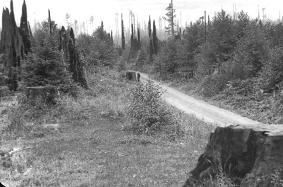 |
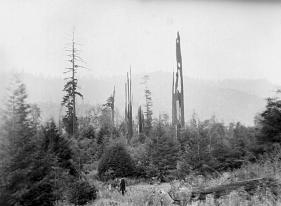 |
Near Trinidad, Humboldt Co., Calif. (<1936) Lantern Slide. American Environmental Photographs Collection, [AEP Image Number, e.g., AEP-cas268], Dept. Special Collections, Univ. Chicago Library. |
Humboldt County., California (<1936) Lantern Slide. American Environmental Photographs Collection, [AEP Image Number, e.g., AEP-cas78], Dept. Special Collections, Univ. Chicago Library. |
Logging history weighs heavily on the restoration needs of individual stands. Management practices varied tremendously through the 20th century and different treatments sometimes affected the way forests regenerated. Forests that were logged 75-150 years ago were often burned repeatedly after the trees were felled to reduce the tremendous volume of bark, limbs and foliage that logging produced. Slash fires were often far hotter than prior fires not only because of extra fuels, but because surface fuel moistures, temperatures and wind speeds increased with the loss of the shading canopy. On some sites, this history of post-logging fire may have increased early stand diversity beyond what is typical of more recent post-logging management.
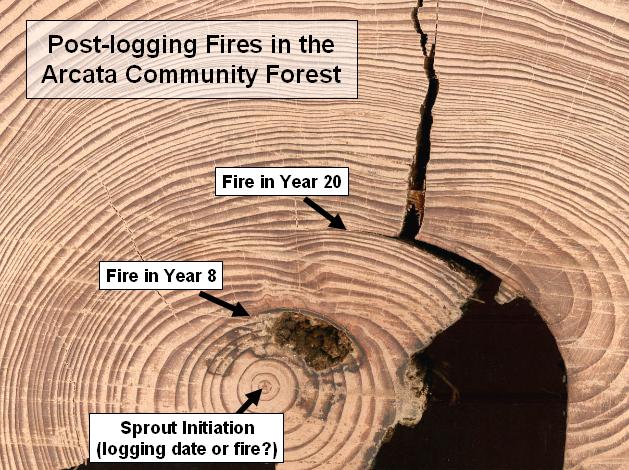
|
Repeated fires burned through the 19th and early 20th centuries on many early-logged sites because residents and property owners were concerned about the risk of wildfire. But during the 1920s and 1930s, early foresters became concerned that residents' promiscuous use of fire delayed or even impeded forest recovery. Apart from causing seedling mortality, fire easily scars redwood and pockets of decay form easily (left). This can reduce wood quality, but that is not an objective when restoring forest complexity in Parks.
|
During the 1930s, the foresters' views won out over the traditional views of Native Americans and early Euro-American settlers. Broad-scale use of fire was outlawed, and fire use was confined to treating logging-related slash immediately after logging occurred. Because of these and other changes in forest management, forest succession during the second half of the 20th century would follow a different course.
If it were not for coast redwood's incredible ability to sprout, forest recovery might have become radically different. Sprouting ensures that redwood could solidly maintain its foothold in forests (right-top). Other contenders for space in north coast forests--like Sitka spruce (right-bottom)--aren't so fortunate. Like Douglas fir, western hemlock, grand fir and red cedar, Sitka spruce must seed in to ensure being perpetuated on the site. Redwood can also reproduce from seed, but seed viability is often low.
In our short modern experience with coast redwood, we envision sprouting as an adaptation to fire and wind breakage. It is obviously not an adaptation to logging, and perhaps because of this, when logged redwood sprout they present special issues for managers of commercial timber land and parks and reserves. |
|
Basal sprouting provides some insurance that redwood can recover quickly after logging, but sometimes there are too many sprouts and no individual wants to dominate fast enough. When sprouts are thinned too soon, the dominant leader slows its growth because many sprouts are needed to sustain the original root system. All old growth stumps don't sprout (only 69 percent of stumps larger than a meter in diameter sprouted in the Arcata Community Forest). Also, old growth forests have a naturally low tree density, so sprouts tend to be highly clustered. This legacy leaves broad open areas without sprouts that become dominated by hardwoods or seeding conifers. Tree compositional differences among old growth and second growth stands can take a century or two to blur, but age analysis indicates that once established after disturbance, Douglas fir can persist for centuries. This suggests that the structural and compositional legacies of logging will be profound and very long-lasting.
After clearcut logging, sprouting, seeding or planted conifers compete with sprouting hardwoods, especially on dry and interior sites. Given their objectives, the lumber industry preferred homogenous stands of redwood and Douglas fir, so they worked hard to reduce hardwood cover through high-density aerial seeding, planting and spraying (Thornburgh et al. 2000). Where timber companies were most successful, stands became homogeneous, lacking the diversity that characterized the earlier post-logging forests that grew up with repeated fires. Today, these dense, stagnating stands typically have minimal shrub, herbaceous or wildlife diversity. To overcome this lingering legacy of logging, managers look for ways to accelerate forest recovery by restoring stand complexity.
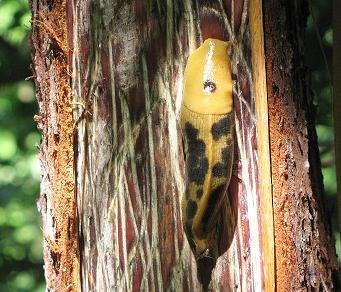
|
An important novel constraint on how second growth redwood is managed on the north coast involves wildlife. Some black bear have developed a sweet tooth and they find satisfaction by stripping the bark off saplings and even small trees to get at the cambium. While partial girdling does not kill the tree, an analysis of scars and healing tissue indicates that the same tree is often attacked repeatedly over several years. The rapid growth that follows thinning appears to make the trees more desirable. Leaving slash on the ground after restoration thinnings may protect trees, but this presents a tradeoff, because untreated slash can have severe effects when a wildfire occurs.
|
Given its long history in coast redwood forests, what possible role might prescribed fire play in second growth management? A warming climate may mean that an occasional wildfire is inevitable, and dry second growth forests may better survive wildfires if they are subjected to regular prescribed fire. As the 2003 Canoe Fire showed us, second growth forests are susceptible to wildfire and high-density patches of mortality are counter to long-term goals.
Sustaining Old Growth
At least since the 1940s, astute observers noticed that old growth forests were changing. Emanuel Fritz wrote in 1944 that fire exclusion had led to understory infilling, and that the forest no longer looked as impressive as it once did (quoted in Finney 1991). His argument had two components: (1) fires used to be frequent and (2) the loss of fire is having an effect on vegetation. Over the coming decades, tree ring evidence indicated that fires had been remarkably widespread across most of the coast redwood range (Brown and Swetnam 1994; Brown and Baxter 2003; Finney and Martin 1992; Stephens and Fry 2005). The apparent exception to this frequent fire hypothesis was the most humid, northernmost forest. Early research in the north found limited evidence of fire (Veirs 1982), but for methodological reasons, this, like several other early efforts farther south, systematically underestimated the occurrence of fire. More recent research has found that fire was common in the north too with any exceptions retreating into the most humid, most protected portions of the landscape that were farthest from human influence (Norman).
The second part of Fritz's argument has been more difficult to resolve because the vegetational effects of fire exclusion in coast redwood have been less well studied. Veirs (1982) inferred that pulses of Douglas fir establish in association with severe fire events, and recent work confirms this dynamic in both Del Norte Coast Redwoods State Park and in Headwaters Reserve (Norman).
Stuart (1987) and Brown and Kaye (1999) showed that redwood had sprouted after historical fires, consistent with the disturbance model put forth by Stone and Vasey (1968). Observations following the 2003 Canoe Fire strongly support this for redwood (right). From this growing body of evidence, it appears that long-term fire exclusion will reduce opportunities for tree establishment, at least on sites that experience no flood or little wind disturbance. |
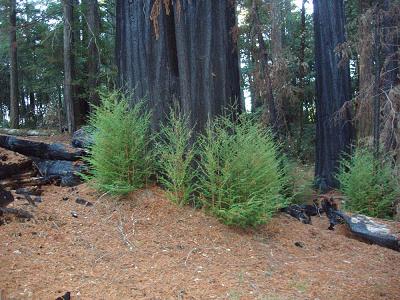 |
Of additional concern for the long-term sustainability of old growth is the accumulation of fuels paired with the risk of infrequent wildfire. When wildfire occurs in areas that have long experienced fire exclusion, it burns more severely than in the past due to increased litter, duff, coarse wood and live fuels. Inside tree cavities, a gradual increase in the extent of decayed wood since the last fire can similarly increase the magnitude of fire effects. Fire exclusion alters long-term wildfire-related risks.
With less frequent but more severe fire effects, residual stands will likely experience more abrupt change than was typical of the pre-fire exclusion period. This change will likely impact the largest and most valued elements of the forest: its oldest and most complex trees. Any sudden loss of large numbers of centuries-old redwood is inconsistent with long-term management goals.
Restoring landscapes
The possibilities of landscape restoration are largely constrained by patterns of land ownership. Some coast redwood units are so small that they can only be managed for individual values; but others are sufficiently large that they allow for broad-scale, long-range planning and management.
This vision is not new. After the devastating hydrological effects of the 1955 and 1964 floods along Bull Creek in Humboldt Redwoods State Park, managing watersheds spurred Save the Redwoods League into thinking holistically. The watershed concept was copied with the recent acquisition of Mill Creek in Del Norte Coast Redwoods State Park.
Beyond the concept of the watershed, all manner of forest elements and processes require large tracts to function. Unnatural edges alter the risk of windthrow, patterns of natural fire severity grade along topographic features, and wildlife movement and dynamics often require large areas to be sustained.
When landscapes are available for restoration and planning, local objectives are more likely to be based on this larger context, and a more sustainable vision. The importance of context was made clear in the Canoe fire. Following decades of fire exclusion, a substantial portion of the upland prairies of Humboldt Redwoods State Park had been type converted to encroaching Douglas fir forest. For centuries, the Native Lolangkok had burned these hilltops for edible seed, grasshoppers and to attract more game. The Canoe fire killed many of these invading trees, providing a partial restorative influence (below).
A sustainable landscape integrates these inherent broad-scale propensities of disturbance along with other modern day resource and social constraints. In the words of Aldo Leopold, having large areas to work with allows us to begin "thinking like a mountain."
![Upland Canoe fire effects, 2004 [Credit Rocco Fiori, California Dept of Parks and Recreation]](images/Credit-RoccoFiori_UplandCanoeFireEffects_2004.jpg)
Challenges of Long-Term Sustenation
At the core of society's dilemma of whether or not to bring fire back into the coast redwood forest is the fact that most historical fires were of human origin. Even though anthropogenic fire had been burning in some stands for millennia, frequent fire seems unnatural, unless we accept ourselves as part of nature. Unlike the dry pine and mixed conifer forests of the West, the ecological need for fire is much more nuanced on the redwood coast. While fire was profoundly important in the past, we can chose to make it less common in the future; but this decision would have important ecological and societal consequences.
These consequences can be best thought of as management tradeoffs. They present us with hard choices that affect whether key forest attributes will be sustained over the long-term. We have long valued attributes, or outcomes more than the processes that sustain them, and because of this human tendency it is easy to adopt a protectionist, passive management attitude in coast redwood. Every ancient tree is worth valuing for its own sake, but are we unable to sustain the forest for the trees? Are we unable to maintain the habitat for the nest? Such tradeoffs are profoundly difficult to weigh, but the future of individual elements and landscapes are contingent on whatever we decide to do.
I end this essay with a few examples of the tradeoffs that we face as we attempt to restore and sustain the superlative:
(1) Old growth redwood and Douglas fir can collapse during wildfires (far fewer would during prescribed fires) and every tree provides potential habitat for the Marbled Murrelet, an endangered seabird that lives in the canopy. Over the long term, fire provides the complex habitat that Murrelets prefer and fire exclusion may ultimately reduce habitat quality.
(2) Northern Spotted Owls prefer a more open understory for foraging than what results from fire exclusion. Left unchecked over the long term, understory change may erode historical high quality habitat. While a rare wildfire may restore foraging habitat in the short term, its higher-than-normal severity can lead to more overstory mortality that reduces nesting sites in the stand.
(3) Residents and visitors expect high air quality and both wildfire and prescribed fire can affect this. But a well managed prescribed fire regime can reduce the risk of having an extended period of hazardous air quality that results from a much more costly wildfire.
(4) Many parks and reserves lie adjacent to homes and built infrastructure, and broadscale prescribed fire could reduce the inherent hazards associated with living near wildlands; yet with any broadscale fuels treatment, there is always a risk of escape.
(5) Sudden oak death, an introduced pathogen, is expected to kill tanoaks across the coast redwood forest. While dead and down tanoak can decay in a decade or two, during the interim, the fire hazard profoundly increases, particularly on dry, exposed slopes. Burning that pre-treats and post-treats fuels before and after the mortality wave occurs may minimize undesirable effects to large trees that can readily sustain severe injuries when fuel levels increase.
(6) Given the unusually long period of fire exclusion and the ever-growing amount of woody fuel that is slow to decay, restoration efforts in old growth may already be decades too late to sustain vast numbers of old trees over the very long-term. Given woody fuel accumulation, any fire use today may lead to anomalously broad scars that are difficult or impossible for the trees to heal over. Ultimately, repeated fires result in cavity formation and accelerate tree collapse, but repeated fires also reduce fire intensity and the risk of cavity initiation and rapid expansion. Given the apparent low risk of wildfire (that could change at any time) and ever-growing fuel hazards, what would you do?
_____
References Cited
Brown, P.M. and Baxter, W.T. 2003. Fire history in coast redwood forests of the Mendocino Coast, California. Northwest Science. 77: 147-157.
Brown, P.M. and Kaye, M.W. 1999. Fire history in Douglas-fir and coast redwood forests at Point Reyes National Seashore, California. Northwest Science. 73: 205-215.
Brown, P.M. and Swetnam T.W. 1994. A cross dated fire history from coast redwood near Redwood National Park, California. Can. J. For. Res. 24: 21-31.
Finney, M.A. 1991. Ecological effects of prescribed and simulated fire on the coast redwood (Sequoia sempervirens D.Don)Endl.) PhD Dissertation. Univ. Calif. Berkeley.
Finney, M.A. and Martin, R.E. 1992. Short fire intervals recorded by redwoods at Annadel State Park, California. Madrono, 39: 251-262.
Stephens, S.L. and Fry, D.L. 2005. Fire history in coast redwood stands in the northeastern Santa Cruz Mountains, California. Fire Ecology 1:1-19.
Stone, E.C. and Vasey, R.B. 1968. Preservation of coast redwood on alluvial flats. Science. 159: 157-161.
Stuart, J.D., 1987. Fire history of an old-growth forest of Sequoia sempervirens (Taxodiaceae) forest in Humboldt Redwoods State Park, California. Madrono. 34: 128-141.
Thornburgh, D.A., Noss, R.F., Angelides, D.P., Olson, C.M., Euphrat, F. and Welsh Jr., H.H. 2000. Managing Redwoods.In: Noss, R.F. (ed.) The Redwood Forest: History, Ecology and Conservation of thet Coast Redwoods.Island Press, Washington D.C. pp. 229-261.
Veirs, S.D. 1982.Coast redwood forest: stand dynamics, successional status, and the role of fire. In. Means, J.E.(ed) Forest succession and stand development resaerch in the northwest. Forest Research Laboratory, Oregon State University. 119-141.
Related Pages:
Steve Norman
|
|

